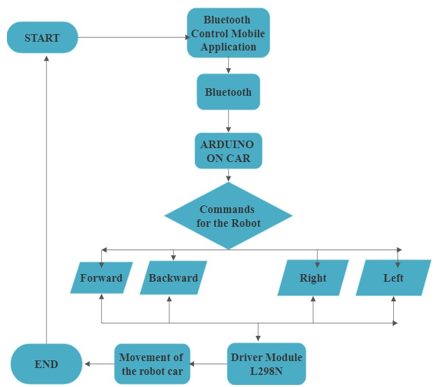Design and Implementation of an IoT-Enabled Bluetooth Robot Car with Obstacle Avoidance
Keywords:
Bluetooth robot car, Obstacle avoidance, Internet of Things (IoT), Proportional-derivative controller, Communication protocolAbstract
Integrating IoT with robotics has the capacity to create pioneering and proficient solutions in various domains. This paper explains how a robot car that uses Bluetooth technology to avoid obstacles was designed and implemented for navigation within designated areas. The article explores the mathematical framework and procedures for identifying and evading obstacles. Moreover, it includes coverage of Bluetooth communication both ways—from the controller to the car and vice versa. The algorithm uses a PD controller to detect and avoid obstacles. Moreover, the Bluetooth communication algorithm creates a dependable communication link connecting the controller and the car, regularly transmitting sensor data and control input. Adjusting the frequency of sensor readings and data transmission rate can optimize algorithmic time complexity. The Bluetooth robot car's successful implementation showcases how IoT and robotics can be leveraged to develop innovative, effective solutions. This serves as a useful reference point for anyone interested in designing comparable systems. Additional progress may involve incorporating machine learning techniques to enhance obstacle detection and avoidance, creating more streamlined communication protocols, and investigating autonomous operation.
Downloads
References
Prof. Swati Khawate, Komal Prajapati, Yash Anand, & Kakshil Chandodwala. (2022). Voice Controlled Robotic Car using Arduino. International Journal of Scientific Research in Science, Engineering and Technology, 119–129. https://doi.org/10.32628/ijsrset122934
Vieira, R., Argento, E., & Revoredo, T. (2022). Trajectory Planning For Car-like Robots Through Curve Parametrization And Genetic Algorithm Optimization With Applications To Autonomous Parking. IEEE Latin America Transactions, 20(2), 309–316. https://doi.org/10.1109/tla.2022.9661471
M, P., & K, D. S. D. (2023). ICN Scheme and Proxy re-encryption for Privacy Data Sharing on the Block Chain. International Journal of Computer Engineering in Research Trends, 10(4), 172–176.
Chachin, P. (2017). IoT in transportation: connected and autonomous cars. ELECTRONICS: Science, Technology, Business, (8), 154–158. https://doi.org/10.22184/1992-4178.2017.169.8.154.158
Lu, C. H., & Hu, Y. L. (2013). Speech Control System for Robot Based on Raspberry Pi. Advanced Materials Research, 791–793, 663–667. https://doi.org/10.4028/www.scientific.net/amr.791-793.663
Yeom, K. (2022). Design of Deep Neural Network Based Model Predictive Controller for a Car-like Mobile Robot. International Journal of Mechanical Engineering and Robotics Research, 606–613. https://doi.org/10.18178/ijmerr.11.8.606-613
Obstacle Detection and Avoidance Methods for Autonomous Mobile Robot. (2016). International Journal of Science and Research (IJSR), 5(1), 1245–1249. https://doi.org/10.21275/v5i1.nov152937
Baldovino, R. G., & Dadios, E. P. (2017). A Fuzzy Proportional-Derivative (PD) Algorithm for Programmable Logic Controller (PLC). Advanced Science Letters, 23(11), 11400–11403. https://doi.org/10.1166/asl.2017.10292
Rudra Kumar, M., Rashmi Pathak, and Vinit Kumar Gunjan. "Machine Learning-Based Project Resource Allocation Fitment Analysis System (ML-PRAFS)." Computational Intelligence in Machine Learning: Select Proceedings of ICCIML 2021. Singapore: Springer Nature Singapore, 2022. 1-14.
Manikandan, G., & Srinivasan, S. (2012). Traffic Control by Bluetooth Enabled Mobile Phone. International Journal of Computer and Communication Engineering, 66–69. https://doi.org/10.7763/ijcce.2012.v1.19
Suneel, Chenna Venkata, K. Prasanna, and M. Rudra Kumar. "Frequent data partitioning using parallel mining item sets and MapReduce." International Journal of Scientific Research in Computer Science, Engineering and Information Technology 2.4 (2017).
M. M. Venkata Chalapathi, M. Rudra Kumar, Neeraj Sharma, S. Shitharth, "Ensemble Learning by High-Dimensional Acoustic Features for Emotion Recognition from Speech Audio Signal", Security and Communication Networks, vol. 2022, Article ID 8777026, 10 pages, 2022. https://doi.org/10.1155/2022/8777026
M, P., & K, D. S. D. (2023). ICN Scheme and Proxy re-encryption for Privacy Data Sharing on the Block Chain. International Journal of Computer Engineering in Research Trends, 10(4), 172–176. https://doi.org/10.22362/ijcertpublications.v10i4.11
Benaziza, W., Mallem, A., & Slimane, N. (2018). PD Terminal Sliding Mode Control Using Fuzzy Genetic Algorithm for Mobile Robot in Presence of Disturbances. Journal of Automation, Mobile Robotics and Intelligent Systems, 12(2), 52–60. https://doi.org/10.14313/jamris_2-2018/11
B. Swathi, M. R. Kumar, M. Riyaz Belgaum and Z. Alansari, "Emotion Recognition Using Bayesian Learning from a Multi-Label Data Corpus," 2022 International Conference on Computing, Networking, Telecommunications & Engineering Sciences Applications (CoNTESA), Skopje, North Macedonia, 2022, pp. 17-22, doi: 10.1109/CoNTESA57046.2022.10011330
A, M., & G.V, S. (2017). Zigbee Transmitter for IoT Wireless Devices. International Journal of VLSI Design & Communication Systems, 8(5), 1–13. https://doi.org/10.5121/vlsic.2017.8501
Andersen, R., Brogaard, R., & Boukas, E. (2023). Autonomous Robotic Inspection for Remote Inspection Technique Systems: A Review. Field Robotics, 3(1), 69–96. https://doi.org/10.55417/fr.2023002
Bezawada , M., & P, V. K. (2023). Comparative Study on Techniques Used for Anomaly Detection in IoT Data. International Journal of Computer Engineering in Research Trends, 10(4), 177–181. https://doi.org/10.22362/ijcertpublications.v10i4.12

Downloads
Published
How to Cite
Issue
Section
License

This work is licensed under a Creative Commons Attribution-ShareAlike 4.0 International License.
All papers should be submitted electronically. All submitted manuscripts must be original work that is not under submission at another journal or under consideration for publication in another form, such as a monograph or chapter of a book. Authors of submitted papers are obligated not to submit their paper for publication elsewhere until an editorial decision is rendered on their submission. Further, authors of accepted papers are prohibited from publishing the results in other publications that appear before the paper is published in the Journal unless they receive approval for doing so from the Editor-In-Chief.
IJISAE open access articles are licensed under a Creative Commons Attribution-ShareAlike 4.0 International License. This license lets the audience to give appropriate credit, provide a link to the license, and indicate if changes were made and if they remix, transform, or build upon the material, they must distribute contributions under the same license as the original.





